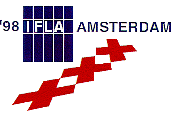
As of 22 April 2009 this website is 'frozen' in time — see the current IFLA websites
This old website and all of its content will stay on as archive – http://archive.ifla.org

As of 22 April 2009 this website is 'frozen' in time — see the current IFLA websites
This old website and all of its content will stay on as archive – http://archive.ifla.org





The IFLA World Directory of National Union Catalogues (IWDNUC) is a union of catalogue of union catalogues, made available on Iflanet, IFLA's web site. This means it is a Directory which lists all the union catalogues available in any country. It aims to serve a basic need for interlibrary loans libraries in particular: how to find out which library in the world holds a particular item. Having perhaps exhausted the catalogues of libraries in one's own country, how can one access the union catalogues of libraries in, for example, Poland, in order to locate an elusive Polish journal? The IWDNUC is a starting point for these types of searches.
The Directory is an IFLA initiative which is supported by a number of sections:
The data has been compiled by the staff of the UAP Office, and is overseen by a working group of representatives from all the supporting sections and institutions. The information has been collected by means of a questionnaire sent to all national libraries, and other institutions known to be responsible for national union catalogues.
So, which catalogues are included?
The Directory lists national union catalogues. This means that catalogues which cover only libraries in one region of a country, or only a certain number of libraries in a country, are generally excluded. This decision is not always clear-cut, as there are many important regional catalogues which are used by libraries outside the region, and in areas of doubt, these catalogues have been included.
The Directory also lists catalogues which are currently maintained, and not those which are now closed. Although this is usually clear-cut, a case can be made for including those catalogues which may be closed, but are still of great value, for example because they cover a specific sector of material (such as ancient Mongolian manuscripts), where holdings information is unlikely to change over the years, and there is no alternative information available. Again, benefit of the doubt has been given, and such catalogues included in the Directory.
Many of the catalogues listed are the union catalogues covering the major national collections of a country, and are general in subject coverage. Specific subject catalogues are also included, so long as they are national in coverage.
The records provide information about each catalogue, covering subject, date range, the size of the catalogue, and the number of contributing libraries.
Also included is some information on how far ISSNs are used, and whether or not ISDS records are used for serial listings.
Of course, the most important information is how you can access the catalogue, and how to obtain the material which is listed in that catalogue.
In order to ensure a comprehensive Directory union catalogues are included, even when they are not accessible from outside the managing library. For example, the British Library Document Supply Centre's Union Catalogue of Books, which has holdings records on cards for thousands of older monographs, is listed in the Directory although it is not accessible outside the BLDSC, because it is a major finding tool for older material, and it is useful to be aware of its existence.
Where the union catalogue is accessible on the internet, then the url has been provided, and a clickable link allows you to go directly from the Directory to the union catalogue. Telnet access details are also provided where appropriate.
For all records, there are of course full contact details for the responsible organisation.
A number of countries which responded have no national union catalogues. This information is also recorded in the Directory, to ensure as complete a listing as possible.
The Directory is still a very new initiative, and the listing which is now available is seen very much as a first edition, with obvious omissions, and possibly already some out of date information. Plans for future development include:
The directory is available at http://archive.ifla.org/VI/2/duc/index.htm